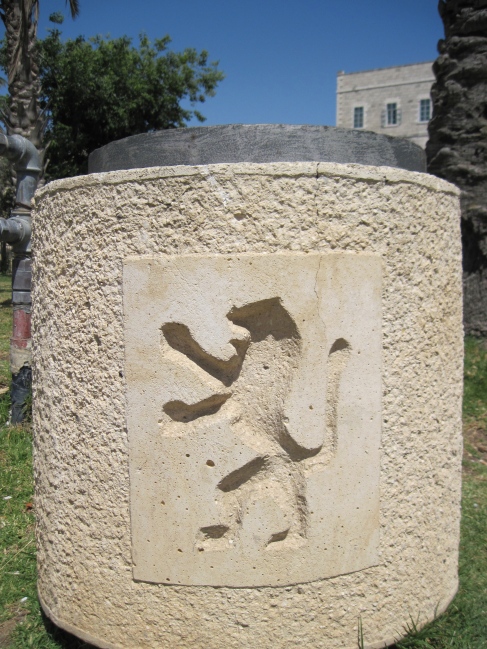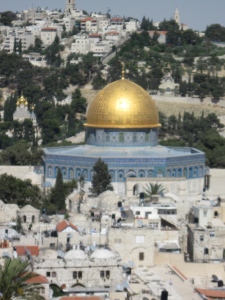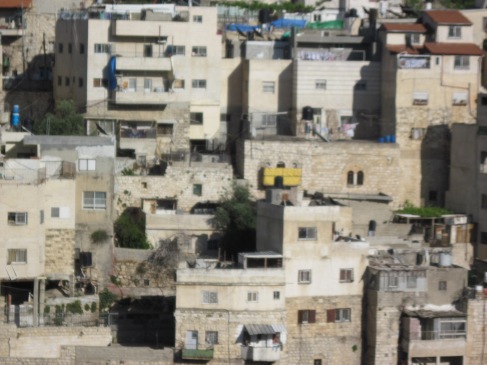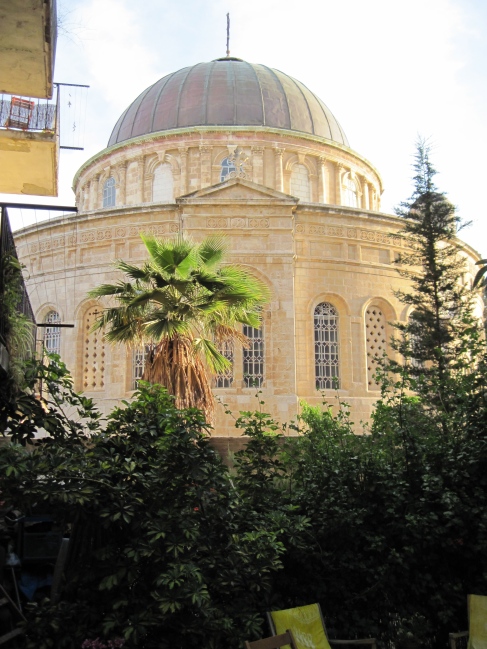–by Matthew Riter
In May of 2009, my mother and I traversed France over 10 days. On our final day, at a Paris hotel, I perused cheap flights on the Internet, chancing upon a low-cost Belgian airline, Jetairfly, with one-way flights from Liege, Belgium, to Tel Aviv, for 99 euros. In Jerusalem, my nephew, Guy, and his mother, Miri, agreed to shelter me from the incoming cultural storm. My nerves tingled as I considered the implications: Judea, Israel, Jerusalem, the Temple Mount and Mount of Olives; wading in the Jordan River, floating in the Dead Sea; entering a sanctified land, an ancient realm; the backbone, heart, and soul of Western civilization; the impetus, departure point, and destination of innumerable spiritual pilgrimages; the land of Jewish temples, Christian crusades, and Arab conquest. These are the sage-covered, olive-filled, Judean Mountains that a multitude of faiths cling to with bandaged hands. The allure of the people, their shared history and culture, and the landscape of the Levant, would surely foster mindfulness.
After escorting mother to the airport, I caught a Thalys high-speed train to Liege, a university town in the rolling, wooded hills of eastern Belgium, with the Meuse River meandering through. Boarding the plane the next day, I encountered men, women, and children, leaning over seats, standing in aisles, talking, laughing, eating, and drinking. The atmosphere persisted, except for takeoff and landing, when the crowd went wild (I later learned Israeli’s do that on every touchdown through the air). I found myself between a 24-year-old Russian Jew from Tel Aviv, and a middle-aged, Jewish homemaker from the coast of Belgium. The Russian had spent the previous three years in peripatetic travels, a common rite of passage for young Israelis fresh out of the army. For the homemaker, frequent flights to Israel provide an opportunity to visit family and friends. The two freely offered advice and piqued my curiosity with anecdotes of the approaching Holy Land.
Shortly past midnight, we touched down at Ben-Gurion Airport. Outside, the air felt hot and heavy, even at this hour. Shalom, and welcome to Israel. I hopped on board a 15-passenger shared taxi, known as a sherut, energized as a 5 year-old on Christmas Eve, bound for Jerusalem. We crossed plains lined with orange groves, skirting the Latrun Monastery, where monks have taken a vow of silence, but nonetheless sell wine produced with grapes grown in their vineyards. The last 10 miles, we meandered through Judean foothills, surrounded by soaring cypress, olive groves, and dry desert shrubbery. Arab and Jewish villages overlook the freeway and rusted-out military vehicles, remnants from the 1948 Arab-Israeli War, seek repose along sections of the road. As we entered Jerusalem, the lights revealed a city built of stone, cleverly carved into the surrounding hillsides.
Since the early 20th century, municipal laws have required all buildings to be faced with Jerusalem stone, ensuring an enduring aesthetic appeal to the city. Today, modern stone towers dot the skyline. Yet, unlike towers of glass and steel, they do not detract from the city’s historicity or authenticity. Jerusalem stone gives the city a candid charisma and a golden hue, with the scorching Mediterranean sun reflecting off sturdy stone structures.
Like the serpentine road snaking its way from the beaches of Tel Aviv into the Judean Mountains, Jerusalem is mystical, mythical, medieval even, considering all the stone structures that abound. Jerusalem, from the Hebrew, Yerushalayim, etymologically, “City of Peace.” It has been continuously inhabited since at least 4000 BC. The city appears in Egyptian records in the 18th and 19th centuries BC, known variously as Rušalimum or Urušalimum. Its footprint and inhabitants have shifted over the centuries. Jews settled the City of David, the oldest district in the present city, in the 4th century BC.
Today, the metropolis includes West Jerusalem, East Jerusalem, and the Old City. West Jerusalem sprung up during the late 19th and early 20th centuries as waves of Jewish immigrants arrived. East Jerusalem, predominately Arab, is home to over 200,000 Palestinians, and developed alongside, but not necessarily with, West Jerusalem. The Old City, including Armenian, Muslim, Christian, and Jewish Quarters, has wearily held its ground since the Ottoman Sultan, Suleiman the Magnificent, built the present walls around it in the 16th century. Israel destroyed a fifth neighborhood, the Moroccan Quarter, in 1967. Over 800,000 people now call Jerusalem home, forming the largest city in Israel.
I drifted into the city on a dry, warm Monday morning in mid-May. After a short night’s rest, I wandered toward the Ben Yehuda District, the heart of West Jerusalem. Now, the sun bounced off nearby limestone buildings, threatening to steal my sight. I found an outdoor café, and sat, sipping coffee, shading my eyes, and watching passersby. Afterward, I honed in on Guy and Miri’s apartment, on the fabled Ethiopia Street, a few short blocks uphill from the Ben Yehuda District.
Ethiopia Street comprises a twisting block-long alley, with cars parked on the west, a limestone wall on the east, and pedestrians dodging light, but tight traffic traveling at variable speeds. Horse hitches line the limestone blocks, remnants from the 19th century. Eliezer Ben Yehuda, namesake of the district I’d just had coffee in, and who fortified Modern Hebrew, lived on the lane in the late 19th century, perhaps daily negotiating the same route I’d just taken. In the 1880’s, Ethiopian Emperor Menelik II constructed the Tewahedo Orthodox Church (pictured below).
Early in my stay, Miri introduced me to the Mahane Yehuda Market, the bustling shouk of West Jerusalem, where local police and Israeli army stand guard at each entrance. On several outings, we dined at the diminutive cafés (seating anywhere from 6 to 12 people) serving up hot Israeli dishes (influences from France, Eastern Europe, the Mediterranean, and Middle East). At one café, I dined on stuffed grape leaves, filled with rice, ground lamb, and Indian spices. At another, I sampled Hungarian goulash; a stewed beef dish in a thickened tomato sauce, seasoned with copious amounts of paprika and turmeric. Fresh pitas, hummus, and pickled vegetables served as appetizers.
Throughout the city, the extraordinary energy of the people and each individual nuance leaves a lasting impression. The music from Arab shops swells, a hollow Middle Eastern melancholy. Jewish street musicians deftly entertain passersby with drums, keyboards, stringed instruments, or spirited singing. Chanting and bells reverberate from churches. Minarets call Muslims to prayer. Rabbis chatter to themselves. The people, forever pacing, talking on cell phones, or to each other, in Hebrew, Arabic, Yiddish, English, Spanish, French, Russian, Ge’ez. These are the residents and tourists of Jerusalem, engaging life from the center stage. Dressed in the garb of their ancestors, treading enigmatic environs, emanating a blinding light. This is Jerusalem, a city infused with enduring myth and living legend. And it’s Israel, bounded by Mediterranean, Dead, and Red Seas; its neighbors a mix of reticent friendliness and marked hostility: Lebanon, Syria, Jordan, and Egypt. Israel’s 20th century birthing pains included wars with each country. Jerusalem now aches with old age, wooden floorboards creaking like the brittle bones of an octogenarian. Stone structures abound, the city seems sculpted from solid rock, a perpetual project over thousands of years.
No facet of Jerusalem caught my eyes, ears, and nose as much as the labyrinth, the maze that is the Old City. In every direction, stand a myriad of merchants, selling clothes, religious paraphernalia, sweets, meats, fish, fruit, vegetables, olives, nuts, or spices. Others run machine shops, jewelry shops, Internet cafés, or antique stores. Roman ruins abound. A cacophony of sights, sounds, and smells tempt, tease, and torture the senses. The shops measure a maximum of 30 feet deep and 10 feet wide, miniscule to my Western eyes. Sandwiched in between, fighting for space, are churches, mosques, and synagogues. The children and their laughter carom through the streets, yet some, even at 10 or 12, are working, pushing unbalanced, dilapidated carts of halva, dried fruit, or Challah bread through narrow alleys, wheels on carts bouncing up and down stone steps.
Inspired by intricacies, I purposefully lose my bearings, as if wandering the Old City offers the singular method to experience it. I meander along pathways leading through quaint neighborhoods, yet seeming to lead nowhere in particular, having been supplemented as centuries passed. Dead ends are common. The stone paths wind, ever upward, downward, over rooftops, into courtyards, or backyards, and then down again, reaching alleys lined with merchants, covered in 5000 years’ worth of wear and tear, etched from the souls of mankind’s most magnificent milestones. I discover a route out of the maze, but invariably return to the Old City, pulled by its relentless ethereal energy.
Its monuments are imprinted in my mind’s eye: the Temple Mount, Western Wall, Church of the Holy Sepulchre, Jaffa Gate, Zion Gate, Lion’s Gate, Herod’s Gate, Damascus Gate, Dung Gate, and Golden Gate; the Kidron Valley, Hinnom Valley, Tyropoeon Valley, and Golgotha, where tradition maintains the Romans crucified Jesus. Each resident with his own panache, often adorned with a cloak, robe, or suit; perhaps wearing a turban, top hat, kippah, kufiyah, hijab, or veil. Young Arab men sporting crew-cuts; Orthodox priests dressed in full cloak with ponytail and bushy beard; Ashkenazi Rabbis seeming to defy death. Young Jewish boys dressed in 19th century, Eastern European attire with yarmulke and side curls. Muslim women veiled from head to toe, peering into the world. Monks, priests, and holy men stroll these streets, as their forefathers did so many moons before. Jerusalem has no bounds, forever leaning toward the Heavens.
Looking back, I wonder how my first experience in Jerusalem changed me. The antiquity of the city repeatedly strikes a chord of deep interest. The determination of its multi-faceted residents fascinates me. So too, each culture resonates to a varying degree. I showed up with paltry knowledge of Jerusalem and its inhabitants, and more questions than answers grew inside me. One summation: the place brings seekers and seeks bringers.
The night before leaving, as happens, I booked a flight from Tel Aviv to Athens, Greece, with El Al, Israel’s national airline. And so it was, 6 weeks after arriving, I waited at Ben-Gurion Airport, ready to continue the adventure. Athens also captured my attention, but that’s a story for another day. Suffice to say, the crowd went wild on that touchdown too. Yet, the Levant and its cornerstone, Jerusalem, the golden, righteous, city of stone, eternally tattooed my psyche.




You have a very vivid, lucid writing style. I’m licking the hummus off my lips as I write.
Keep up the good work and safe travel.
Thanks for the encouragement. Your work is an inspiration…
-Matthew
City of Peace! Such a wonderful notion. And a terrific experience, I can tell 🙂
Many thanks for following my blog. Happy travels!
Happy travels to you too! I can’t wait to explore the City of Peace again.
You had me from beginning to end. I think Jerusalem just went on the list. I read parts out loud to Don and he was captivated too. I think I learned something about descriptive writing.
Thank you for following our blog. I hope you enjoy the stories of our journey. Alison
Thanks so much for the kind words, Allison. Jerusalem is indeed a special place. Let me know if you need any tips for a visit.
Hi Matthewriter. It seems to me watching the news it’s become another battlefield! Thank you for liking my poem Battlefield! Peace and Best Wishes. The Foureyed Poet.
Jerusalem is a nice place ,peoples in this city were having a kind heart and helping nature ..
It is very good place for pilgrims and a sign of peace …….
I wish to be citizen of this city for rest of my life because I love laws which were applicable in this country ……